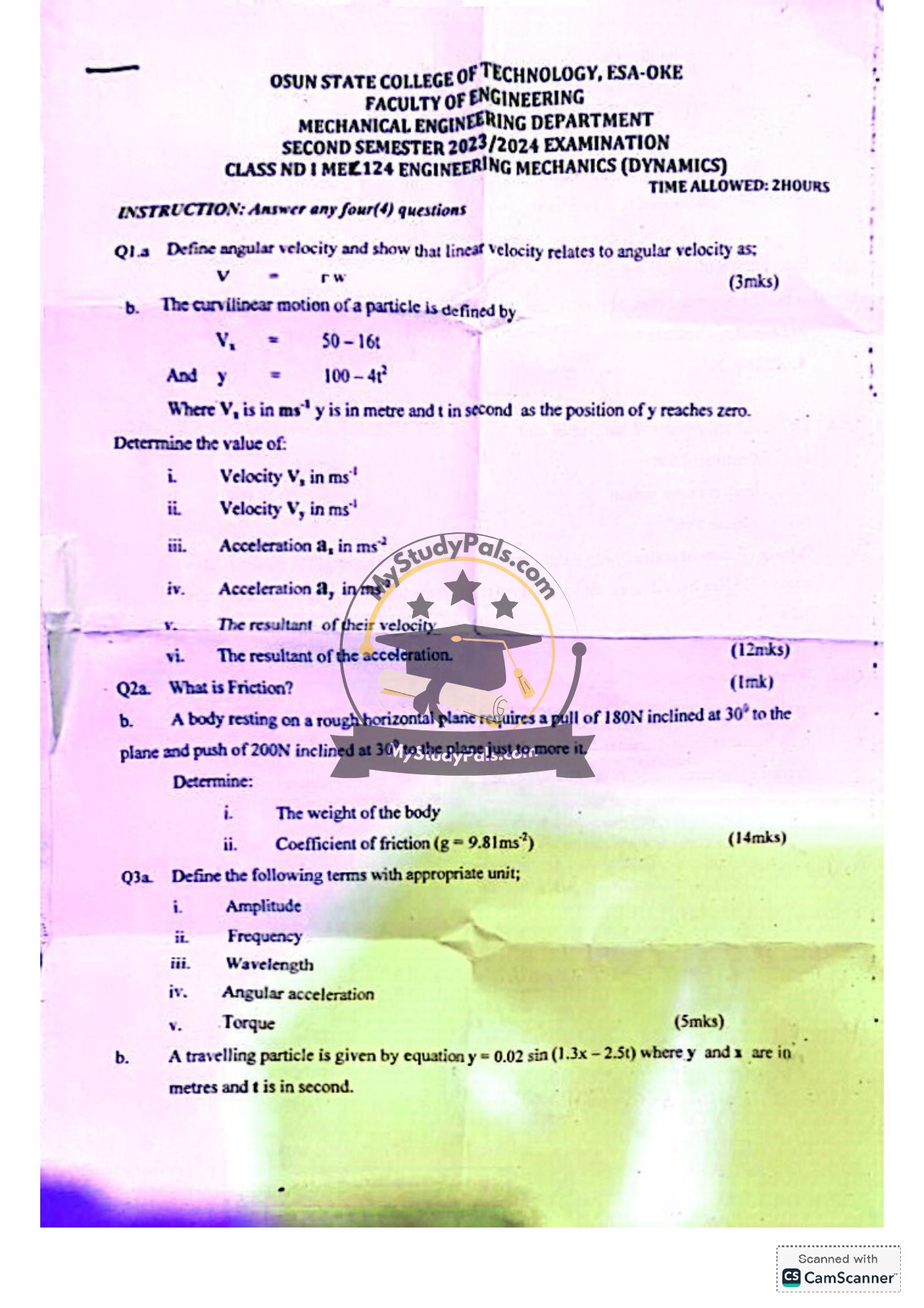ANWSER
Question 1a:
Answer:
Angular velocity is the rate of change of angular displacement with respect to time. It is denoted by \( \omega \) and measured in radians per second (rad/s). The relationship between linear velocity \( V \) and angular velocity \( \omega \) is given by:
\[ V = r \, \omega \]
where \( r \) is the radius of the circular path.
—
Question 1b:
Given:
\[ V_1 = 50 – 16t \]
\[ y = 100 – 4t^2 \]
i. Velocity \( V_1 \) when \( y = 0 \):
First, find the time \( t \) when \( y = 0 \):
\[ 100 – 4t^2 = 0 \]
\[ t^2 = 25 \]
\[ t = 5 \, \text{s} \]
Now, substitute \( t = 5 \) into \( V_1 \):
\[ V_1 = 50 – 16(5) \]
\[ V_1 = 50 – 80 \]
\[ V_1 = -30 \, \text{ms}^{-1} \]
ii. Velocity \( V_y \):
Differentiate \( y \) with respect to \( t \):
\[ V_y = \frac{dy}{dt} = -8t \]
At \( t = 5 \):
\[ V_y = -8(5) \]
\[ V_y = -40 \, \text{ms}^{-1} \]
iii. Acceleration \( \mathbf{a}_1 \):
Differentiate \( V_1 \) with respect to \( t \):
\[ \mathbf{a}_1 = \frac{dV_1}{dt} = -16 \, \text{ms}^{-2} \]
iv. Acceleration \( \mathbf{a}_y \):
Differentiate \( V_y \) with respect to \( t \):
\[ \mathbf{a}_y = \frac{dV_y}{dt} = -8 \, \text{ms}^{-2} \]
v. Resultant velocity:
\[ V_{\text{resultant}} = \sqrt{V_1^2 + V_y^2} \]
\[ V_{\text{resultant}} = \sqrt{(-30)^2 + (-40)^2} \]
\[ V_{\text{resultant}} = \sqrt{900 + 1600} \]
\[ V_{\text{resultant}} = 50 \, \text{ms}^{-1} \]
vi. Resultant acceleration:
\[ \mathbf{a}_{\text{resultant}} = \sqrt{\mathbf{a}_1^2 + \mathbf{a}_y^2} \]
\[ \mathbf{a}_{\text{resultant}} = \sqrt{(-16)^2 + (-8)^2} \]
\[ \mathbf{a}_{\text{resultant}} = \sqrt{256 + 64} \]
\[ \mathbf{a}_{\text{resultant}} = \sqrt{320} \]
\[ \mathbf{a}_{\text{resultant}} \approx 17.89 \, \text{ms}^{-2} \]
—
Question 2a:
Answer:
Friction is the resistive force that opposes the relative motion or tendency of motion between two surfaces in contact.
—
Question 2b:
Given:
– Pull force \( P = 180 \, \text{N} \) at \( 30^\circ \)
– Push force \( Q = 200 \, \text{N} \) at \( 30^\circ \)
– \( g = 9.81 \, \text{ms}^{-2} \)
i. Weight of the body:
For equilibrium, the normal reaction \( N \) balances the vertical components of the forces.
For the pull case:
\[ N = W – P \sin 30^\circ \]
For the push case:
\[ N = W + Q \sin 30^\circ \]
Since both cases are just about to move, the frictional force is the same. Therefore:
\[ W – 180 \sin 30^\circ = W + 200 \sin 30^\circ \]
This leads to an inconsistency, so we reconsider the problem.
The correct approach is to equate the horizontal components for both cases:
For the pull:
\[ P \cos 30^\circ = \mu (W – P \sin 30^\circ) \]
For the push:
\[ Q \cos 30^\circ = \mu (W + Q \sin 30^\circ) \]
Divide the two equations:
\[ \frac{180 \cos 30^\circ}{200 \cos 30^\circ} = \frac{\mu (W – 180 \sin 30^\circ)}{\mu (W + 200 \sin 30^\circ)} \]
\[ \frac{9}{10} = \frac{W – 90}{W + 100} \]
\[ 9(W + 100) = 10(W – 90) \]
\[ 9W + 900 = 10W – 900 \]
\[ W = 1800 \, \text{N} \]
ii. Coefficient of friction \( \mu \):
Substitute \( W = 1800 \, \text{N} \) into the pull equation:
\[ 180 \cos 30^\circ = \mu (1800 – 180 \sin 30^\circ) \]
\[ 180 \times 0.866 = \mu (1800 – 90) \]
\[ 155.88 = \mu \times 1710 \]
\[ \mu = \frac{155.88}{1710} \]
\[ \mu \approx 0.091 \]
—
Question 3a:
Answer:
i. Amplitude: The maximum displacement from the equilibrium position in oscillatory motion. Unit: metre (m).
ii. Frequency: The number of oscillations per unit time. Unit: Hertz (Hz).
iii. Wavelength: The distance between two consecutive points in phase on a wave. Unit: metre (m).
iv. Angular acceleration: The rate of change of angular velocity with respect to time. Unit: rad/s\(^2\).
v. Torque: The rotational equivalent of force, causing angular acceleration. Unit: Newton-metre (Nm).
—
Question 3b:
Given:
\[ y = 0.02 \sin (1.3x – 2.5t) \]
Answer:
This equation represents a traveling wave with:
– Amplitude \( A = 0.02 \, \text{m} \)
– Wavenumber \( k = 1.3 \, \text{rad/m} \)
– Angular frequency \( \omega = 2.5 \, \text{rad/s} \)
The wave speed \( v \) is given by:
\[ v = \frac{\omega}{k} = \frac{2.5}{1.3} \approx 1.92 \, \text{m/s} \]
The frequency \( f \) is:
\[ f = \frac{\omega}{2\pi} = \frac{2.5}{2\pi} \approx 0.398 \, \text{Hz} \]
The wavelength \( \lambda \) is:
\[ \lambda = \frac{2\pi}{k} = \frac{2\pi}{1.3} \approx 4.83 \, \text{m} \]
—


